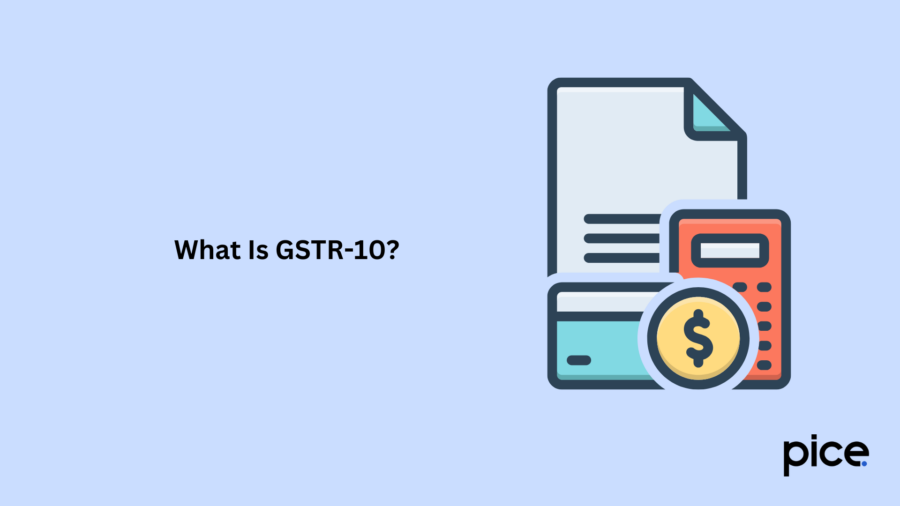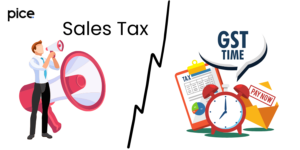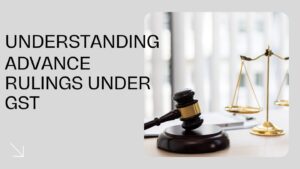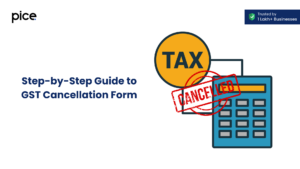GSTR 10 Late Fees Eligibility, Rules & Filing Returns
- 30 Jan 25
- 9 mins

GSTR 10 Late Fees Eligibility, Rules & Filing Returns
Key Takeaways
- Final Return: GSTR-10 is mandatory for cancelled or surrendered GST registrations.
- Due Date: File within three months from the later of cancellation or order date.
- Stock & Tax Reporting: Declare closing stock, tax liabilities, and ITC reversal.
- Penalties: Late filing attracts ₹100/day, up to 0.25% of turnover.
- Compliance: File pending returns, ensure accurate reporting, and authenticate digitally.
GSTR-10 is the final return you need to file if you have opted for the cancellation of GST registration. As per GST law, you are required to submit this return within three months of the cancellation date. In this blog, you will learn all the key details you need to know about this GST return, including GSTR-10 late fees.
What Is GSTR-10?

Also referred to as the 'Final Return’, GSTR-10 is a mandatory form under India's GST framework. It must be submitted by taxpayers whose GST registration has been cancelled or voluntarily surrendered.
The main objective of GSTR-10 is to confirm that all outstanding tax liabilities are settled before the GST account is closed. This form ensures transparency and accountability in the taxation process. It captures information such as stock details, discharged liabilities, and input tax credit (ITC) utilisation. Timely filing of GSTR-10 is essential for closing a GST registration.
What Is the Due Date to File GSTR-10?
You must file GSTR-10 within three months from either the date your GST registration is cancelled or the date of the cancellation order, whichever comes later. For instance, if your GST registration is cancelled on 1st January, 2025, and you receive the cancellation order on 5th January, 2025, you must file GSTR-10 by 5th April, 2025.
Who Is Eligible to File GSTR-10?
GSTR-10 filing must be done exclusively by individuals whose GST registration has been cancelled or voluntarily surrendered. However, the following taxpayers are exempt from filing GSTR-10:
- Non-Resident Taxable Persons (NRTP)
- Taxpayers under the Composition Scheme
- Input Service Distributors (ISD)
- Individuals required to deduct TDS under Section 51 of the CGST Act
- Individuals required to collect TCS under Section 52 of the CGST Act
Details to be Provided in GSTR-10
GSTR 10 comprises a total of 11 sections. Below are the details:
Sections Auto-Populated Upon Login:
- GSTIN
- Business or Trade Name
- Legal Name
- Address for Future Correspondence
Sections Requiring Input:
- Effective Date of Surrender or Cancellation: You have to mention the date of GST registration cancellation as per the issued order.
- Date of Cancellation Order: You need to provide the date on which the authorities issued the GST cancellation order.
- Reference Number of Cancellation Order: Enter the unique ID assigned by the authorities when the cancellation order is issued.
- Tax Payable and Paid: Report ITC reversal or tax payable and its payment through electronic cash and credit ledgers, categorised under IGST, SGST, CGST, and cess.
- Details of Closing Stock: Share the information about the closing stock held at the time of business closure. Input tax credit (ITC) on this stock must be settled through the return.
- 8(a): Inputs in stock (with invoice)
- 8(b): Inputs in semi-finished or finished goods (with invoice)
- 8(c): Capital goods or machinery in stock
- 8(d): Inputs in stock or semi-finished/finished goods (without invoice)
- Interest and Late Fee: Provide a head-wise breakdown of interest and late fees payable and paid.
- Verification: Confirm the accuracy of the details and digitally sign the return using a Digital Signature Certificate (DSC) or Aadhaar-based signature verification.
Here are some important points you must note while declaring stock details:
- If invoices are unavailable for declared stock or inputs in semi-finished/finished goods, the valuation must comply with CGST Rule 44(3), using market value. This valuation requires certification from a practicing chartered accountant or cost accountant. You need to upload it along with the GSTR-10 form.
- For capital goods or machinery, use the prescribed formula:
Invoice value = (1/60th value × number of months from the purchase date). For this calculation, the useful life is assumed to be five years.
Once all details are filled out accurately, ensure the return is authenticated through digital verification.
Format of GSTR-10
The structure of GSTR-10 is designed to gather all essential information required for filing the final return under GST. It is divided into the following sections:
Part 1: Basic Details:
- Legal name and trade name (if applicable)
- GSTIN (GST Identification Number)
- Address of the principal place of business
- Date of cancellation application
Part 2: Details of Closing Stock:
- Capital goods
- Inputs held in stock
- Inputs in finished goods
- Inputs in semi-finished goods
Part 3: Tax payable on Closing Stock:
- Tax amount on capital goods
- Tax amount on inputs
- Tax amount on finished goods
- Tax amount on semi-finished goods
Part 4: Verification:
Declaration along with the signature of the authorised signatory
Late Fees and Penalties for Non-compliance

When GSTR-10 is not filed within the stipulated time, it attracts a penalty fee of ₹100 per day up to a maximum of 0.25% of the taxpayer turnover. A tax registration is valid up to the time when the last and final tax return is filed by the taxpayer.
A taxpayer is bound to file all the other returns and clear all the other outstanding tax obligations. It will also be possible to charge interest for failure to file GSTR-10 as the other non-compliance penalty.
In case a registered taxpayer fails to file GSTR-10 at the time of filing, then the tax authorities will issue a notice. This notice must be given to the taxpayer, and the said return is to be filed by the taxpayer within 15 days of receipt of this notice.
If it fails to meet the required compliance within this period, authorities will issue a final order that contains taxes, fees, interest, and any other penalty for non-compliance. Ignoring the final order can lead to further legal actions.
Exemptions from Filing GSTR-10
Businesses registered under GST that have neither made any supplies nor received goods or services from the date of registration until the date of cancellation or surrender are not obligated to file GSTR-10. Similarly, taxpayers who obtained GST registration but did not commence business and later surrendered their registration are also exempt from filing the final return.
Steps to Avoid Non-Compliance Under GSTR-10
GSTR-10 offers a detailed summary of a taxpayer's financial activities up to the cancellation date. To ensure compliance, taxpayers should follow these key steps:
- Submission Within the Deadline
The final return must be filed within three months from the cancellation date or the issuance of the cancellation order, whichever is later. Delays or failure to file can result in penalties and financial losses.
- Filing After Registration Cancellation
Taxpayers intending to cancel their GST registration must first submit the cancellation request on the GST portal. After receiving the cancellation order from authorities, they must file GSTR-10. The option to file will only be available once the cancellation order is issued.
- Reporting Accurately
Taxpayers should accurately report stock values and related input tax credits. Any errors or false details may lead to penalties or legal repercussions.
- CA or Cost Accountant Certification
For stocks without valid invoices, valuation based on the current market price must be certified by a chartered accountant or cost accountant. The certificate must be uploaded during the filing process. Failure to submit this certificate may result in notices from tax authorities.
- Record Maintenance
Proper documentation of all financial transactions, including invoices and previously filed returns, is essential for compliance.
- Filing GSTR-3B and GSTR-1 First
GSTR-10 cannot be filed until all pending GSTR-3B and GSTR-1 returns are submitted. Taxpayers must ensure that these earlier returns are completed before attempting to file the final return.
- Filing NIL GSTR-10
Even if there are no inputs in stock after GST registration cancellation, taxpayers must file a NIL GSTR-10. It is mandatory to file, regardless of stock status.
- Full Payment of Taxes
GSTR-10 cannot be submitted with unpaid or partially paid taxes.
- Proper Authentication
The final return must be authenticated by the authorised signatory using either a Digital Signature Certificate (DSC) or an Electronic Verification System (EVS).
Conclusion
Overall, you must file GSTR-10 on time to avoid GSTR 10 late fees and any potential legal consequences. However, it is crucial to note that the final return is not similar to the annual return, and you need to file it after cancelling the GST registration.
The officials and businessmen must report accurate details and necessary amounts in order to meet certain liabilities, which are well defined by the act of GST, and should follow the timelines so that hefty penalties can be avoided.
💡If you want to streamline your payment and make GST payments, consider using the PICE App. Explore the PICE App today and take your business to new heights.
 By
By 
















